Posted by: Northwest Eye in General on October 9, 2025
Overview
Drusen of the macula are small deposits that can indicate early signs of age-related macular degeneration (AMD), a leading cause of vision loss in older adults. We understand that learning about these changes can be concerning. While drusen may not present immediate symptoms, their presence, especially in larger quantities, is something we take seriously. Regular monitoring is essential, and we want you to know that there are steps you can take to help maintain your vision health.
Lifestyle changes and specific vitamin supplementation can be beneficial in managing your eye health. It’s common to feel overwhelmed by this information, but remember, you are not alone in this journey. Many people find comfort in making small adjustments to their daily routines, and we are here to support you every step of the way. Together, we can work towards preserving your vision and ensuring your well-being.
Introduction
Drusen of the macula, often overlooked, play a significant role in the health of the eye, especially as we age. These small yellow or white deposits can be benign, yet their presence may signal the onset of age-related macular degeneration (AMD), a leading cause of vision loss. We understand that many may feel uncertain about what this means for their eyesight.
As our population ages, it’s crucial to understand the formation, symptoms, and management of drusen. Many remain unaware of their potential impact on vision.
What steps can you take to monitor and mitigate the risks associated with these deposits? How can you ensure your vision remains protected? We are here to help you through this process.
Define Drusen: Understanding Their Role in Eye Health
Drusen of macula are small yellow or white deposits that accumulate beneath the retina, particularly in the area crucial for central vision. Composed of lipids, proteins, and cellular debris, these deposits are commonly found in individuals aged 50 and older. While their presence is often benign, the drusen of macula can indicate early signs of age-related macular degeneration (AMD), which is a leading cause of vision loss in older adults. It’s important to note that approximately 19.8 million Americans aged 40 and older were living with AMD in 2019, with about 1.49 million experiencing vision-threatening forms of the disease.
We understand that discovering these deposits can be concerning. The identification of drusen typically occurs during routine dilated eye exams, where an ophthalmologist uses specialized tools to examine the retina. Most individuals with eye deposits do not exhibit symptoms, making regular monitoring essential. As experts highlight, the presence of numerous small deposits or larger ones, specifically drusen of macula, can signal the onset of AMD, necessitating further evaluation and potential intervention. Dr. G Atma Vemulakonda emphasizes, “If you have optic nerve drusen without symptoms, you should be monitored regularly.”
The impact of the drusen of macula on vision can be significant, especially when they grow larger, which is linked to dry AMD. Symptoms of AMD may include:
- Hazy vision
- Difficulty adjusting to changes in lighting
- The presence of blank or blurry areas in central vision
Risk factors for AMD encompass:
- Smoking
- Obesity
- Family history
- High blood pressure
- High cholesterol
Understanding the role of drusen of macula in eye health is vital, as early identification and treatment can aid in maintaining vision and reducing the risk of significant vision impairment associated with AMD.
It’s also important to recognize that these deposits can occur in the optic nerve, and small deposits are common in individuals aged 50 and older without AMD. This indicates that not all deposits are indicative of serious eye disease. We are here to help you through this process, ensuring you receive the support and care you need for your eye health.
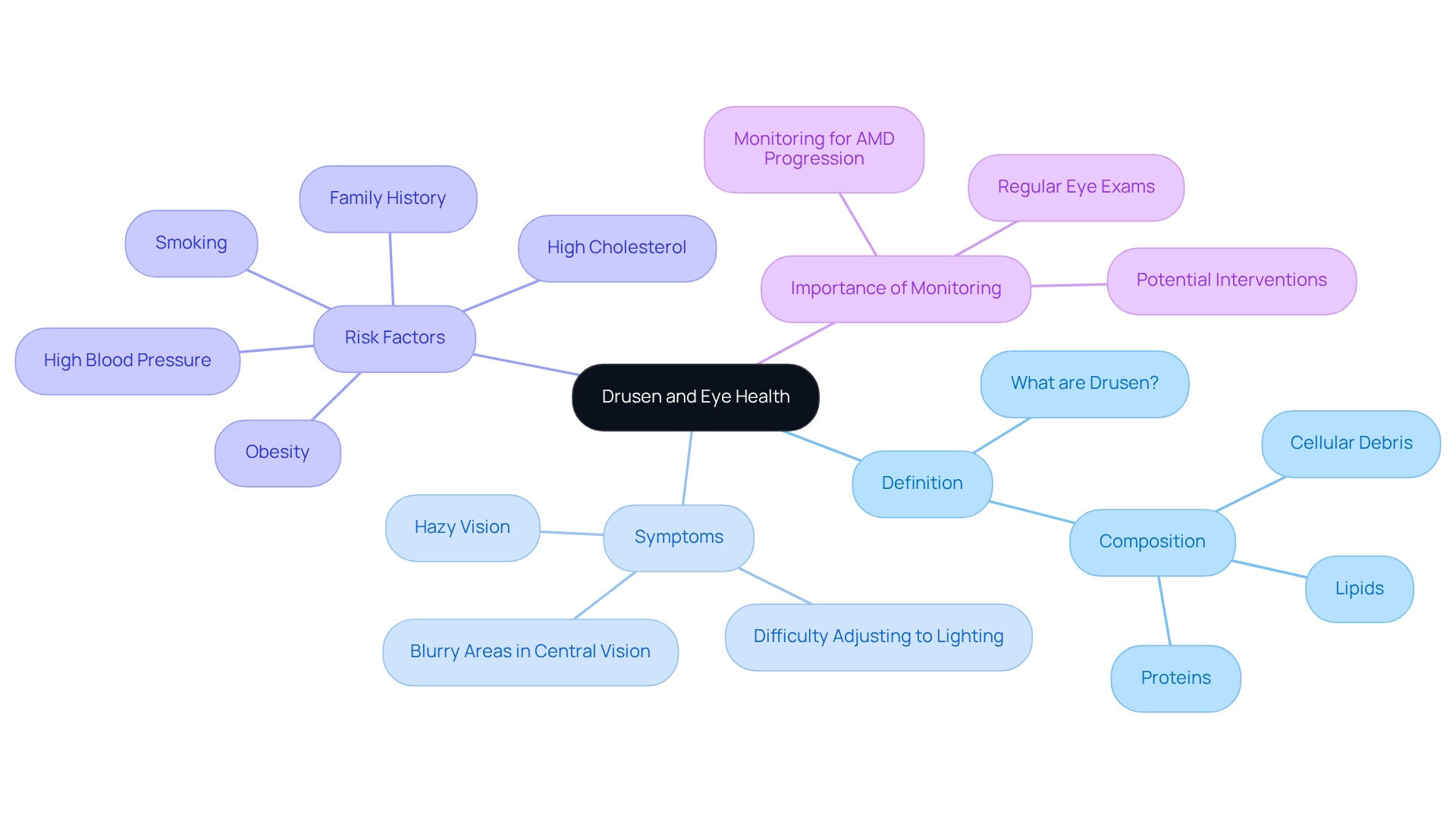
Explore Causes of Drusen Formation and Risk Factors
The formation of drusen of macula is influenced by a combination of aging, genetics, lifestyle choices, and underlying health conditions. We understand that these factors can be concerning, so let’s take a closer look at what contributes to this condition:
-
Aging: It’s common to feel worried about the risk of developing drusen, especially as we age. The likelihood of forming drusen of macula significantly increases after the age of 50, as age-related changes in the retina become more pronounced. The presence of drusen of macula can increase the risk of central vision loss by up to 50%, which highlights the importance of understanding their formation.
-
Genetics: If you have a family history of age-related macular degeneration (AMD), you might wonder about your own risk. A genetic predisposition can increase the probability of drusen of macula deposits forming, particularly in Caucasians, making it an important demographic detail to consider.
-
Lifestyle Factors: It’s understandable to feel overwhelmed by lifestyle choices. Poor eating habits, smoking, and inadequate physical activity are strongly associated with an increased risk of developing drusen of macula. Diets low in antioxidants and high in saturated fats can exacerbate the development of drusen of macula. Dr. M. Ronan Conlon emphasizes that making lifestyle modifications—like following a nutritious diet and engaging in regular physical activity—can be essential for managing eye deposits and lowering the risk of progression to AMD.
-
Health Conditions: Chronic conditions such as hypertension and high cholesterol can also contribute to the formation of drusen of macula, which appear as yellowish deposits. It’s important to recognize that maintaining overall health plays a vital role in eye care. While small deposits may not require immediate treatment, larger drusen of macula might necessitate AMD therapies like anti-VEGF medications.
Additionally, we want you to know that these deposits can develop without symptoms, and they are typically identified during routine retinal diagnostic testing or retinal photography. Preventive measures recommended by the Age-Related Eye Disease Studies (AREDS and AREDS2) include a combination of nutrients to lessen the risks of sight loss. By recognizing these risk factors, you can make informed lifestyle decisions to potentially lower your chances of developing eye issues related to this condition. We are here to help you through this process.
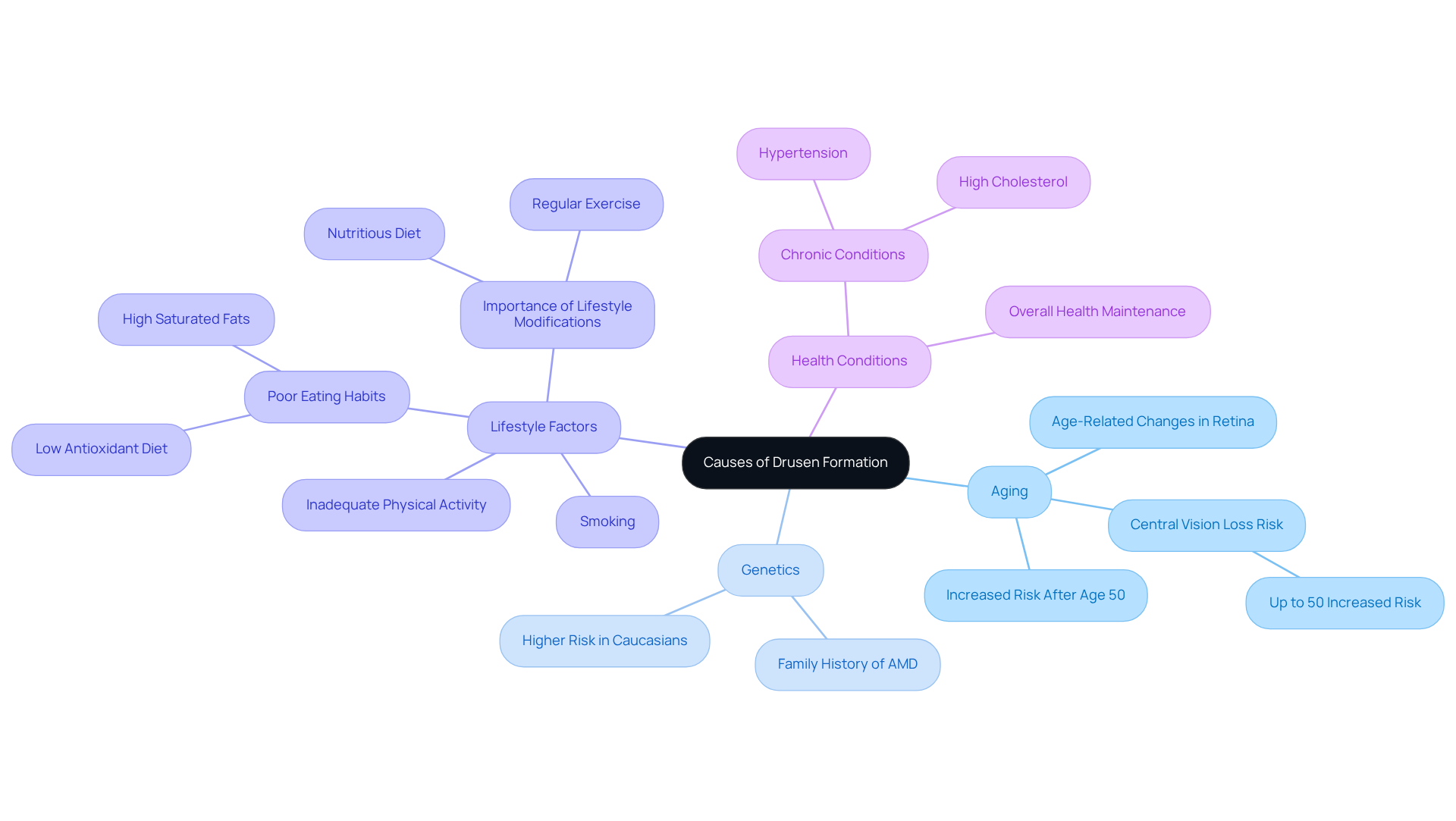
Identify Symptoms of Drusen and Their Impact on Vision
Drusen may not exhibit noticeable symptoms in their initial stages, but as they progress, they can significantly affect your sight. It’s common to feel concerned about changes in vision, and understanding the symptoms associated with drusen can be helpful. Here are some key signs to watch for:
- Blurred Vision: You might find it challenging to see fine details, especially in low-light conditions.
- Distorted Vision: This can manifest as metamorphopsia, where straight lines appear wavy or warped.
- Difficulty with Color Perception: You may notice that colors seem less vibrant or muted.
- Blind Spots: Central sight may be obscured, leading to gaps in your visual field.
Recognizing these symptoms quickly is essential, as it enables timely intervention and management strategies that can help maintain your sight. Recent research suggests that individuals with retinal deposits often experience metamorphopsia, emphasizing the importance of routine eye examinations to monitor changes in vision. For instance, a significant portion of people with yellowish deposits report experiencing blurred or distorted vision, highlighting the need for awareness and proactive care.
We understand that early detection of these symptoms can lead to effective management, potentially slowing the progression of age-related macular degeneration (AMD) and preserving your quality of life. Regular check-ups and utilizing tools like the Amsler grid can assist in identifying these changes, ensuring that you receive the necessary support and treatment. Remember, we are here to help you through this process.
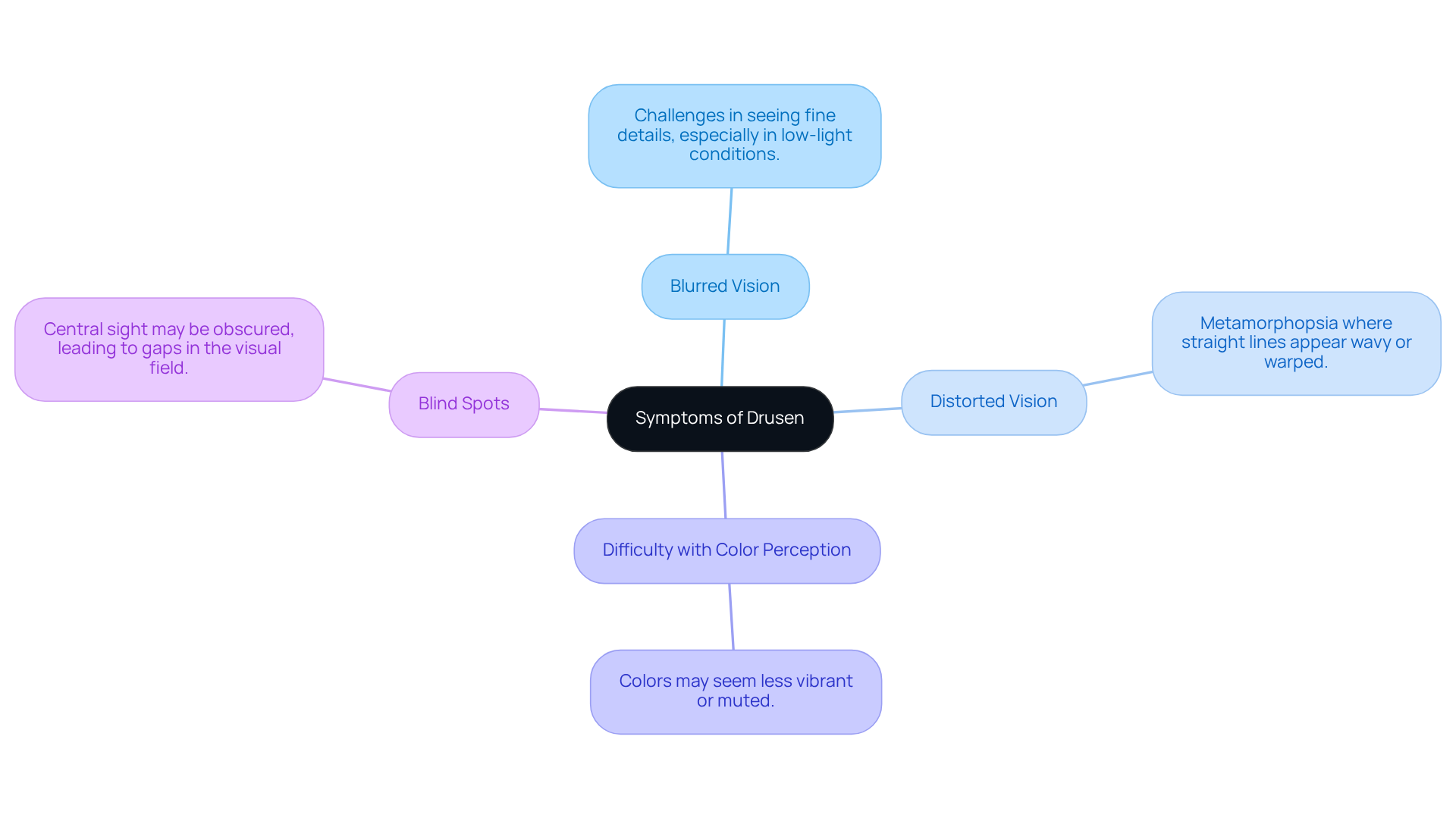
Examine Diagnostic Techniques for Detecting Drusen
We understand that concerns about your eye health can be overwhelming. Several diagnostic techniques are employed to detect drusen and assess their impact on your well-being:
- Comprehensive Eye Exam: A thorough examination by an eye care professional is the first step in identifying drusen, providing you with peace of mind.
- Fundus Photography: This technique captures detailed images of the retina, enabling the observation of yellowish deposits, which is essential for monitoring your eye health.
- Optical Coherence Tomography (OCT): OCT offers cross-sectional images of the retina, allowing for an accurate assessment of the size and position of deposits, ensuring you receive the best care possible.
- Fluorescein Angiography: This test involves injecting a dye into the bloodstream to highlight blood vessels in the retina, helping to assess any associated complications.
It’s common to feel anxious about these procedures, but regular eye examinations employing these methods are essential for early identification and monitoring of deposits. We are here to help you through this process, ensuring prompt action if required. Your eye health is important, and we want to support you every step of the way.
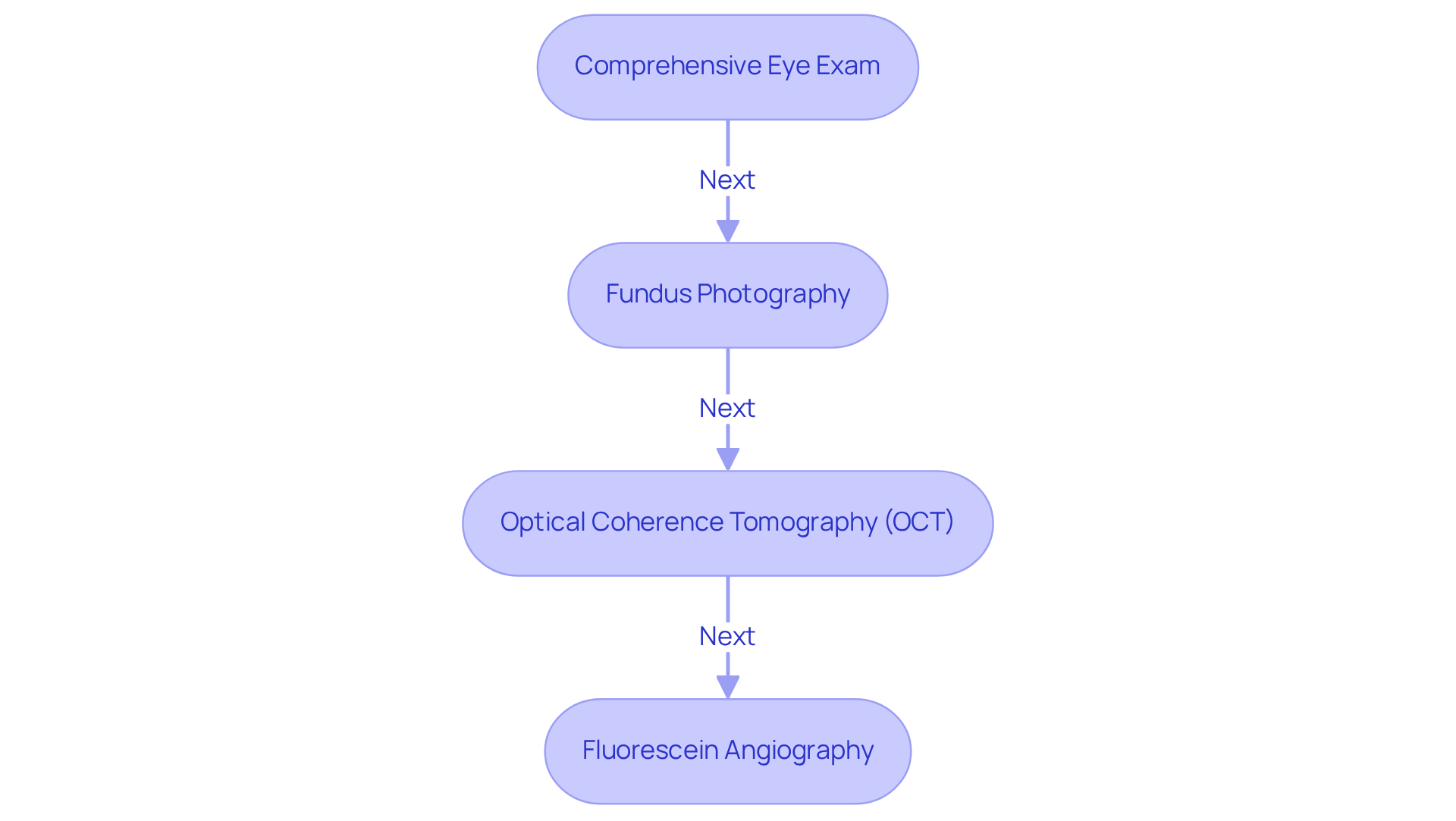
Review Treatment Options and Management Strategies for Drusen
While there is no direct treatment for drusen, several effective management strategies can help mitigate their impact on vision and overall eye health.
We understand that navigating eye health concerns can be overwhelming. Regular monitoring through routine eye exams is essential for tracking changes in drusen and assessing overall retinal health. For individuals with eye deposits, we suggest having these exams every 2 to 4 years. It’s important to note that if you have a parent afflicted with AMD, your likelihood of developing the condition doubles, underscoring the importance of proactive monitoring.
Lifestyle modifications can also play a significant role in your eye health. Adopting a healthy diet rich in antioxidants—such as leafy greens and fish—quitting smoking, and engaging in regular physical activity can notably reduce the risk of progression. Additionally, we want to highlight that high caffeine consumption may increase the risk of blinding eye disease, making it crucial to consider your dietary choices carefully. Studies suggest that these lifestyle changes can slow the advancement of macular degeneration, providing hope for many.
Moreover, vitamins and supplements can be beneficial. Research has shown that certain vitamins, particularly those in the AREDS2 formulation, can help slow the advancement of AMD in individuals with these deposits. This formulation includes 10 mg of lutein, 2 mg of zeaxanthin, and antioxidants like Vitamin C, all of which have been found effective in managing eye health. As Dr. Ruchira Singh wisely noted, “If we can stop the buildup of drusen, we might be able to avert the disease from advancing to a phase where loss of sight happens.”
In advanced cases where sight is significantly impacted, surgical options may be considered. However, these interventions are typically reserved for more severe conditions.
By understanding and implementing these options, you can take proactive steps to manage your eye health effectively. Remember, we are here to help you through this process, potentially preventing the progression of AMD and preserving your vision.
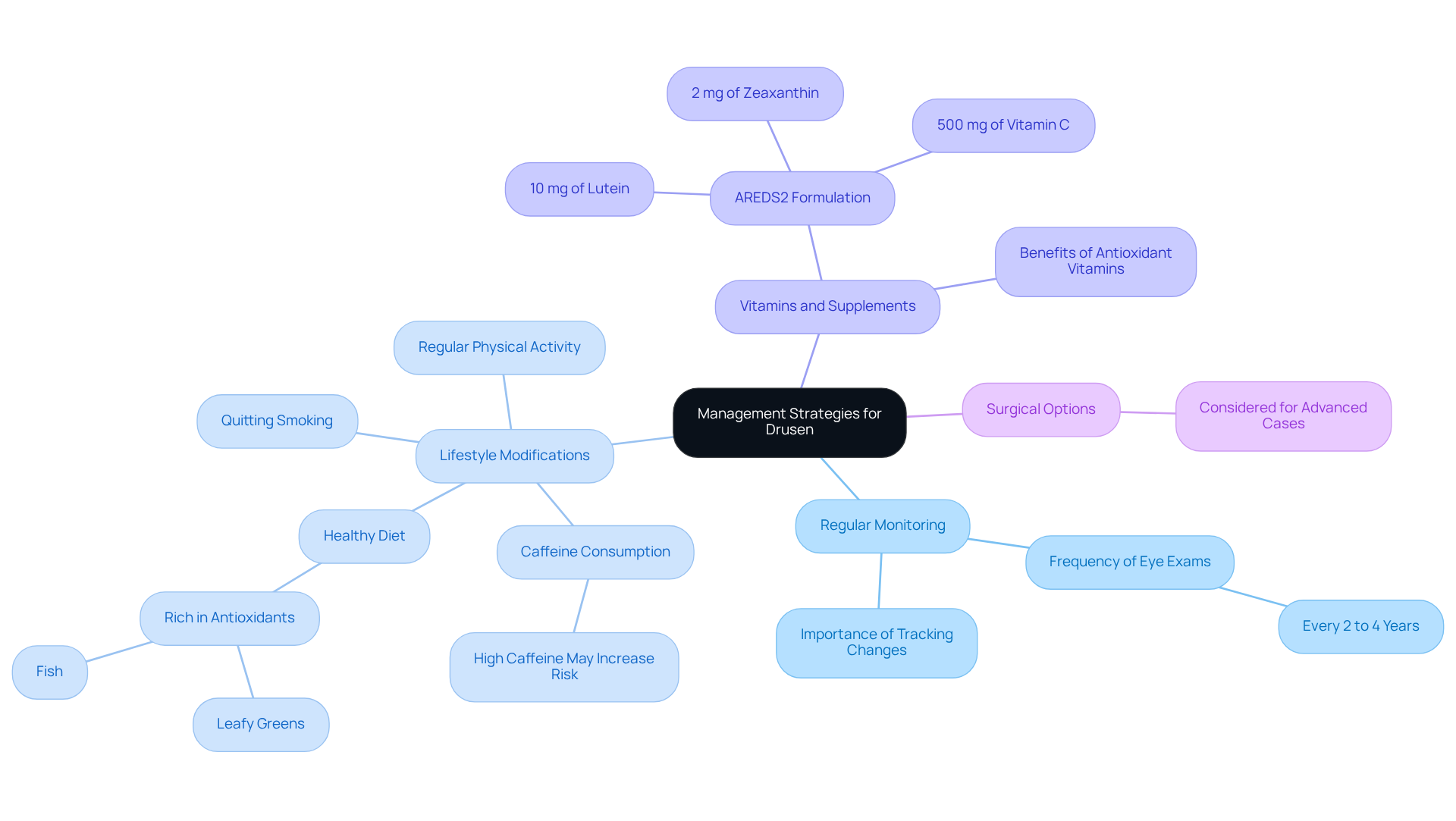
Conclusion
Understanding drusen of the macula is crucial for maintaining eye health. We recognize that these yellow or white deposits can be concerning, especially as they may serve as early indicators of age-related macular degeneration (AMD). While often benign, drusen can lead to significant vision impairment if not monitored and managed appropriately. By acknowledging the importance of regular eye examinations and being aware of the risk factors associated with drusen formation, you can take proactive steps to preserve your vision.
This article explores the causes of drusen formation, highlighting the roles of:
- Aging
- Genetics
- Lifestyle choices
- Chronic health conditions
It’s essential to understand that regular eye exams are vital for early detection. Symptoms such as blurred vision and blind spots should not be overlooked. We also discuss various diagnostic techniques and management strategies that can help mitigate the impact of drusen on your vision, including:
- Lifestyle modifications
- The use of specific vitamins
In summary, being aware of and proactively managing drusen is vital in reducing the risk of AMD and preserving your vision. By making informed lifestyle choices and staying vigilant about your eye health, you can significantly influence your ocular well-being. We encourage you to seek regular eye care and consult with healthcare professionals about any changes in your vision. Together, we can navigate the journey towards optimal eye health with confidence and support.
Frequently Asked Questions
What are drusen and where do they accumulate?
Drusen are small yellow or white deposits that accumulate beneath the retina, particularly in the macula, which is crucial for central vision.
What is the composition of drusen?
Drusen are composed of lipids, proteins, and cellular debris.
Who is most likely to have drusen?
Drusen are commonly found in individuals aged 50 and older.
Are drusen always a cause for concern?
While the presence of drusen is often benign, it can indicate early signs of age-related macular degeneration (AMD), a leading cause of vision loss in older adults.
How prevalent is age-related macular degeneration (AMD) in the U.S.?
Approximately 19.8 million Americans aged 40 and older were living with AMD in 2019, with about 1.49 million experiencing vision-threatening forms of the disease.
How are drusen typically identified?
Drusen are usually identified during routine dilated eye exams conducted by an ophthalmologist using specialized tools to examine the retina.
What symptoms might indicate the presence of AMD?
Symptoms of AMD may include hazy vision, difficulty adjusting to changes in lighting, and the presence of blank or blurry areas in central vision.
What are the risk factors for developing AMD?
Risk factors for AMD include smoking, obesity, family history, high blood pressure, and high cholesterol.
Can drusen occur without serious eye disease?
Yes, small deposits can occur in individuals aged 50 and older without AMD, indicating that not all deposits are indicative of serious eye disease.
What factors contribute to the formation of drusen?
The formation of drusen is influenced by aging, genetics, lifestyle choices, and underlying health conditions.
How does aging affect the risk of developing drusen?
The likelihood of forming drusen significantly increases after the age of 50 due to age-related changes in the retina, which can increase the risk of central vision loss by up to 50%.
What role does genetics play in the development of drusen?
A family history of AMD can increase the probability of forming drusen, particularly in Caucasians.
How do lifestyle factors influence the risk of drusen formation?
Poor eating habits, smoking, and inadequate physical activity are associated with an increased risk of developing drusen, especially diets low in antioxidants and high in saturated fats.
What health conditions can contribute to drusen formation?
Chronic conditions such as hypertension and high cholesterol can contribute to the formation of drusen.
What preventive measures can be taken to reduce the risk of sight loss related to drusen?
The Age-Related Eye Disease Studies (AREDS and AREDS2) recommend a combination of nutrients to lessen the risks of sight loss. Maintaining overall health through lifestyle modifications is also important.






